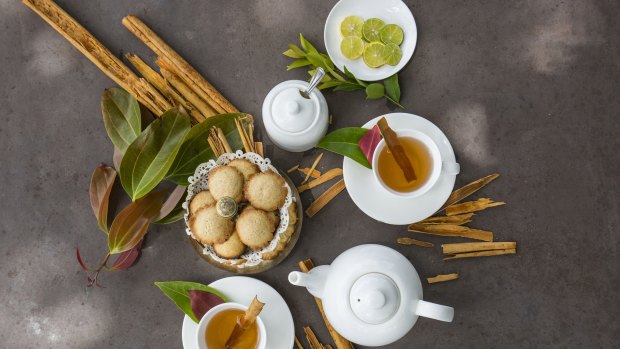This was published 4 years ago
The Sri Lankan ingredient that has the world's gourmands in its thrall
By Mark Chipperfield

Villa Mayurana's 'Cinnamon Experience'.Credit: Abercrombie & Kent
On a dreamy tropical morning in the lush hills outside Galle I'm watching a strong, bearded young man massage a cinnamon branch – plying a brass rod with the delicacy of a cellist tackling a tricky composition by Bach or Haydn.
"By adding more and more pressure, the peeler is loosening the bark, which he can then remove from the branch intact," explains W.K Sugath, a local agronomist and a man with an abiding passion for cinnamon.
Using a small curved blade the peeler, whose name is Madashanka, then scores a line down the entire length of the branch, before removing the bark in single coil.
"He must be careful not to damage the bark," says W.K. "Any holes will open up when the cinnamon is drying and the quills will not be suitable for export."
Covering just 1.5 hectares this cinnamon plantation at Villa Mayurana, a 20-minute drive from Galle Fort, is typical of those found throughout southern Sri Lanka. Harvesting is done by local cinnamon families, where the craft of cutting, peeling and drying has been passed from one generation to the next.
"Both men and ladies do this job," says W.K. "The peelers work as a team. They are in great demand."
Apart from its beguiling flavour when added to soups, tagines, cakes and desserts, cinnamon is also a totally sustainable product. Trees live for up to 70 years and can be harvested every 12 months. Apart from the cinnamon quills, valuable oil is extracted from the leaves. Villagers often burn waste bark and leaves to repel insects.
"Many households keep a small vial of cinnamon oil to treat toothache," says W.K. Like many home cooks I keep cinnamon quills in the kitchen cupboard, but until this trip to Sri Lanka had no appreciation of the artistry, patience and time required to produce such an everyday commodity.
"In Sri Lanka everything is still done by hand, by teams of peelers who travel from one cinnamon plantation to the next," says W.K. "This technique of stripping the outer bark was first developed by the Portuguese almost 400 years ago. The cinnamon trade was then taken over by first the Dutch and then the British."
Long before Ceylon supplied the British Empire with its morning cuppa, the country had seduced the world's gourmands with its intoxicating aroma of cinnamon. "The shores of the island are full of it and it is the best in all the Orient," a Dutch captain once wrote. "When one is downwind of the island, one can still smell cinnamon eight leagues [44 kilometress] out to sea."
As my cinnamon-loving guide is quick to point out Sri Lankan cinnamon (also known as true cinnamon) should not be confused with the lower-grade stuff grown in India and Vietnam, or Chinese cassia, a vastly inferior product. "True cinnamon (cinnamomum verum) is indigenous to Sri Lanka," says W.K with pride. "Low quality cinnamon has thick bark and a bitter taste, while our cinnamon is spicier and sweeter, with a much nicer taste."
Today, Sri Lanka accounts for 85 per cent of the world's production of true cinnamon, with much of it bound for Mexico where it is added to sauces, chocolate and even beer – and also packaged up for the American market.
Cinnamon remains a popular ingredient in Sri Lankan cuisine and following a morning workshop I'm treated to a delicious cinnamon-themed lunch of pumpkin and cinnamon soup, followed by grilled chicken served with roasted organic vegetables and cinnamon-flavoured rice.
But as a child of the hippie era I knew my cinnamon yearnings could not be fully satisfied at Villa Mayurana. "I wanna live with a cinnamon girl," sang Neil Young on his 1970 hit. "I could be happy the rest of my life with a cinnamon girl." Sadly, my cinnamon girl was in distant Australia. I would have to chase the moonlight alone.
TRIP NOTES
Mark Chipperfield was a guest of Abercrombie & Kent.
MORE
FLY
SriLankan Airlines has direct flights from Melbourne to Colombo's Bandaranaike International Airport, with daily departures. See srilankan.com
TOUR
A visit to Villa Mayurana is an experience included in Abercrombie & Kent's Sri Lanka Private Journey. Or join a small group tour and explore Sri Lanka'ssignificant cultural and religious sites, Colombo, Galle and tea plantations on A&K's 14-day Sri Lanka: Secrets of The Spice Island Limited Edition Small Group Journey. Prices from $10,230 a person, includes personal guide, air-conditioned vehicle, boutique accommodation and all entry fees. Departures from March 18, 2020 onwards. See abercrombiekent.com.au
Sign up for the Traveller Deals newsletter
Get exclusive travel deals delivered straight to your inbox. Sign up now.